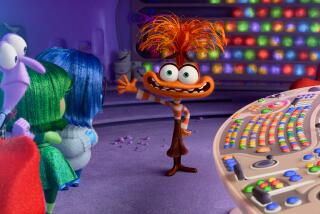Drive-In Theaters Flicker Back to Life
- Share via
LEXINGTON, Va. — For 50 years, Hull’s Drive-In theater on Route 11 was as much a part of summer life in the Shenandoah Valley as Little League baseball or the county fair. It was where teenagers took their first dates and families spread out on lawn chairs before a towering screen, and the America of the 1950s seemed eternal.
Then, in 1998, the longtime owner died, and the drive-in that had opened with John Wayne’s “Wake of the Red Witch” soon went dark. Hull’s was to be demolished, and Lexington was about to join more than 3,000 towns where outdoor cinemas had closed over a generation’s time as land values soared and entertainment tastes changed.
“This is terrible,” Eric Sheffield, a Lexington cabinetmaker, wrote in the local paper. He said Hull’s had been part of the fabric of the town, and added, “If anyone else cares, give me a call and maybe we can do something.”
Flash ahead to the summer of 2003. It is 8:30 p.m. A stream of cars and pickups is pulling into Hull’s -- the nation’s only nonprofit, community-owned drive-in -- for a double-feature, “Spy Kids 3-D” and “Johnny English.” Frank Kulesza, the manager, is fiddling with his 1949 RCA projector.
The voice of Elvis Presley singing “Don’t Be Cruel” booms out of the PA system and rolls over the grassy valley. Families have decamped onto quilts and blankets. One pickup hauling a sofa has backed into a space, its tailgate facing the 50-foot-high screen. A family of four are on the sofa.
“We get doctors to dirt farmers here,” said Peggy Payne, a volunteer ticket-taker and a board member of Hull’s Angels Inc., which raised $75,000, mostly through small donations, enabling the community to buy the business in 2001. “Hull’s is something that sets Lexington apart in an era when it’s unusual to have a drive-in.”
Actually, it’s not quite as unusual as it was a few years ago. However modest the trend, drive-ins are making a comeback in the U.S. after having been on the endangered-species list for more than a decade. Since the mid-’90s, 43 drive-ins have reopened and 20 new ones have been built, according to the United Drive-in Theatre Owners Assn. In August, new drive-ins opened in New York, Illinois, Texas and Tennessee, the most for any month in years.
“You’d be surprised how many people I encounter who think drive-ins no longer exist,” said Randy Loy, the association’s co-executive director. “Yes, they disappeared from many cities and even small towns in the ‘80s and ‘90s, but we’ve got 402 left. The numbers have stabilized, and a new generation is discovering drive-ins.”
The first drive-in was opened in 1938 in Camden, N.J., by Richard Hollingshead, a sales manager at his father’s auto-parts store. He had experimented in his driveway, mounting a 1928 Kodak projector on the hood of his car and tacking a crude screen to some trees in his backyard. To see what effect rain would have on the picture, he turned on the lawn sprinkler.
By 1958, more than 4,000 drive-ins stretched across America. The drive-in in Copiague, N.Y., held 2,500 cars. Drive-ins in Harmony, Pa., and Bamberg, S.C., each had space for just 50. One cinema in Asbury Park, N.J., had an airstrip and parking in the back row for 25 planes. Outdoor movies under the stars were part of the summer landscape of small-town America -- and trying to sneak in free in the trunk of a car was a teenage ritual.
The heyday of the drive-in ended in the mid-1980s. Attendance tumbled as owners found it difficult to get first-run movies and compete with cable TV and VCRs. Shopping malls and theme parks became the big draws. Drive-ins closed by the hundreds as the land they occupied along main highways became more profitable when used for other forms of commercial or residential development.
“Today, although the Thunderbird Drive-In in Fort Lauderdale, [Fla.], has 13 screens, the business is mostly a seasonal, mom-and-pop one, with a single screen, and concessions producing more revenue than ticket sales,” said Loy, whose nonprofit association tracks the industry.
For Lexington and its 6,000 citizens, the season starts in early April with a car parade from downtown to Hull’s Drive-In, four miles away. A five-member board selects the movies to be shown and shuns war films and anything with gratuitous sex. Most of the improvements to the facility are done by volunteers with merchants providing free equipment and material.
Last year, Hull’s grossed more than $200,000 and managed to make a $4,000 profit, while keeping prices low: $1 hot dogs and $4 tickets, with kids under 12 free.
“You couldn’t ask for a better crowd of people than we get,” said Kulesza, the manager, who announces birthdays and anniversaries over the PA during intermissions. “Sure, sometimes kids hide in the trunk coming by the ticket booth, but as likely as not they get to feeling guilty and they’ll come up to the concession stand between features and give you the $4 they owe.”
More to Read
The biggest entertainment stories
Get our big stories about Hollywood, film, television, music, arts, culture and more right in your inbox as soon as they publish.
You may occasionally receive promotional content from the Los Angeles Times.










